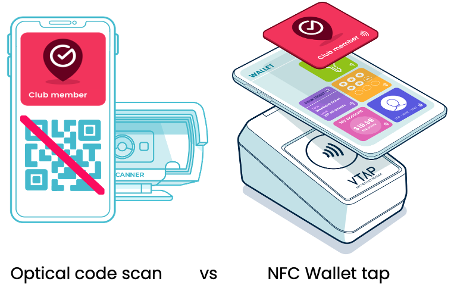QR codes are not good enough for check-in and access
The use of barcodes and QR codes has become ubiquitous and covers many different applications: product identification, advertising, launching web sites, representing tickets, claiming loyalty rewards or proving membership ID. However, some applications, such as front desk check-in, ticketing and access control, require less friction and greater security.
Although QR codes are generally free to create, whether stored within an app or in Apple Wallet or Google Wallet, they do suffer from some key challenges:
- The interaction process is far from frictionless – users must manually unlock their phone, open an app, find the code and wave it under or in front of a scanner – a frustratingly slow experience. This is often even more challenging in environments with limited phone signal or Wi-Fi coverage, or if the app requires re-authentication at exactly the wrong moment!
- Optical codes are easily copied, leading to account sharing and lost revenue. There are some protections that can be put in place, including regularly changing codes, but users have a habit of finding ways around all of these, leading to draconian defences such as ‘airlock’ entry gates and CCTV surveillance. Not the kind of welcoming experience that most brands want to promote.
- The scanning equipment is typically more expensive, physically larger and less intuitive to use than RFID or NFC readers, where customers just tap their tag or phone onto the reader. Optical scanning hardware was originally designed for scanning barcodes from paper tickets and plastic cards, not bright smartphone screens.
The use of ‘just tap’ NFC technology solves these problems and introduces other benefits too. Apple Wallet and Google Wallet have also become ubiquitous over the past few years, thanks partly to the convenience of Apple Pay and Google Pay, but also the ease of adding other types of tickets and passes into their universal wallet apps. What many people don’t know is that these native wallet apps also support NFC for membership cards, as well as event tickets and loyalty cards.
The fitness industry leads the way with NFC Wallet
The fitness industry is probably the furthest forward in terms of adoption, with our VTAP NFC readers leading the revolution! Gym operators have generally been split between those using RFID for identification of their customers, with a card, tag or wristband, and those using barcodes or QR codes. These membership IDs are typically used for access control and/or front desk check-in, whereas RFID is still typically used for lockers and for logging in to the fitness equipment itself.
Today, millions of gym-goers at thousands of gyms already use NFC Wallet to access the facility, thanks to our technology and partnerships with Apple and Google. An NFC pass can be added to Apple Wallet and Google Wallet as easily as a ticket or boarding pass. Once there, it can be called up automatically with a simple tap on an Apple and Google certified NFC Wallet reader: no need to unlock, run apps or select anything in advance!
Why is NFC Wallet so much better than QR codes?
NFC Wallet passes do not display any data that can be copied or shared. An NFC pass can be restricted to devices belonging to the pass owner to prevent digital sharing. And perhaps most importantly, neither Apple or Google charge anything for generating or using these NFC passes (don’t believe anyone who tells you otherwise!)
The user experience for NFC Wallet is much simpler as the reader automatically selects the right card, ready for use, and the ‘just tap’ interaction works without the need for a phone signal or Wi-Fi connectivity.
At Dot Origin, we’ve been working on this technology for over 5 years and have successfully helped businesses of all sizes to adopt it, including major players such as David Lloyd, Anytime Fitness and EGYM.
NFC Wallet is simple, swift and secure, both to use and to implement. You don’t need to replace all your infrastructure, since our readers can act and behave just like an optical scanner or legacy RFID reader, making them compatible with existing systems.
For the fitness industry, an added benefit is that the same NFC pass can be used to log in to equipment, unlock premium services and generally help operators move towards a single, modern, and secure wall-to-wall NFC membership ID solution.

